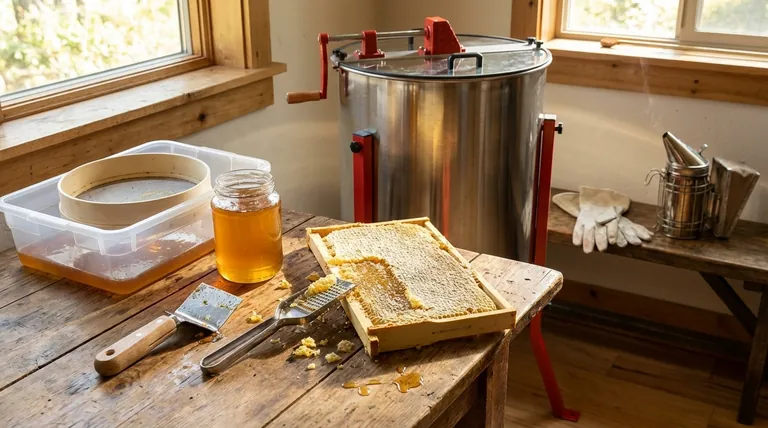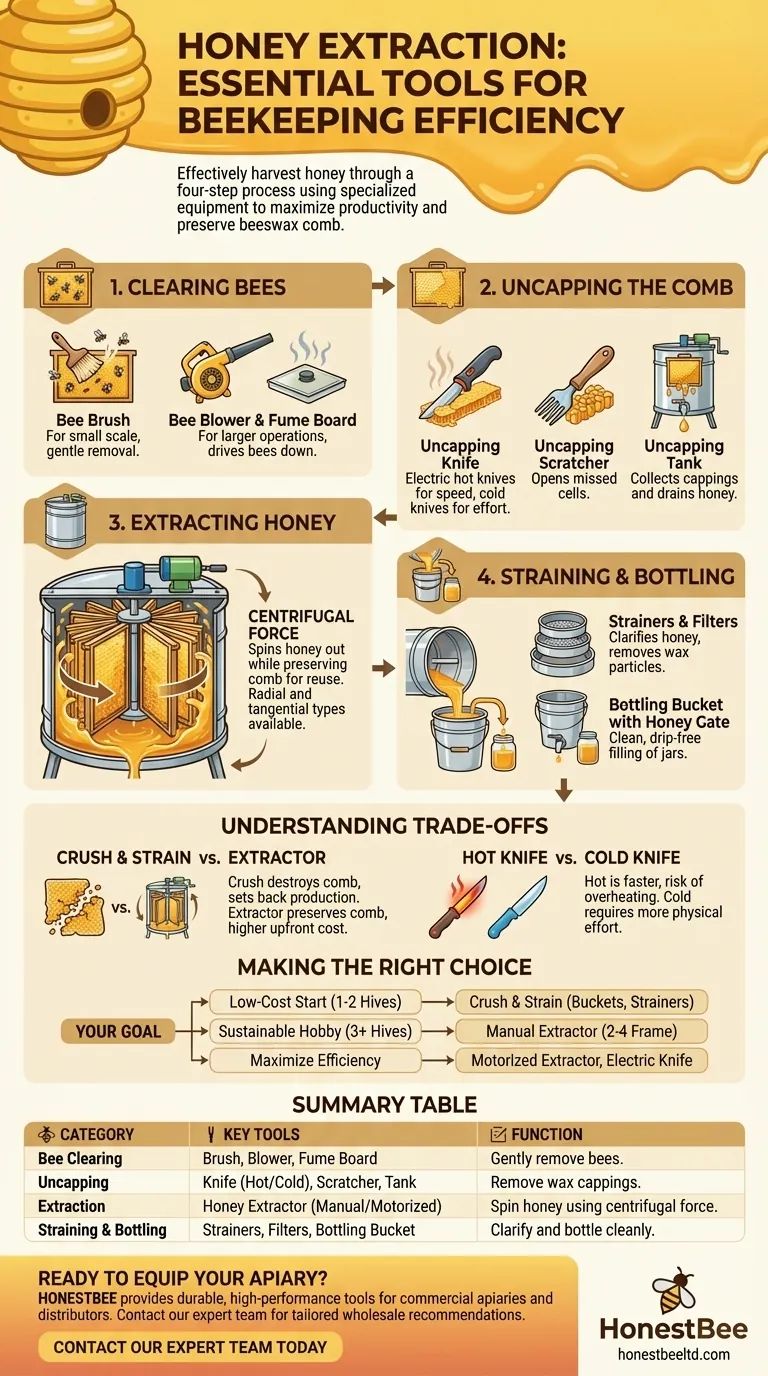To harvest honey effectively, you need a specific set of tools designed for a multi-step process. The core equipment includes an uncapping tool, such as a heated knife or scratcher, to remove the wax cappings from the honeycomb. Next, a honey extractor uses centrifugal force to spin the honey out of the frames, and finally, a system of strainers or filters cleans the honey before it is bottled.
The goal of modern honey extraction is not just to collect honey, but to do so efficiently while preserving the delicate beeswax comb. Using the right tools allows bees to refill the existing comb, saving them immense energy and dramatically increasing your apiary's productivity.

Step 1: Clearing Bees from the Honey Frames
Before you can bring frames indoors for extraction, you must safely and gently remove the bees.
The Bee Brush
A bee brush has very soft bristles and is used to gently sweep remaining bees off the frames. This is a simple, direct method best suited for beekeepers with only a few hives or frames to clear.
The Bee Blower or Fume Board
For larger operations, a bee blower emits a high volume of air to push bees out of the honey supers. Alternatively, a fume board is a lid with an absorbent material that holds a non-toxic bee repellent. When placed on top of the hive, the fumes drive the bees downward, out of the honey boxes.
Step 2: Uncapping the Honeycomb
Once the frames are indoors, you must remove the thin layer of beeswax that seals each cell full of honey.
The Uncapping Knife
An uncapping knife is a long, sharp blade used to slice off the wax cappings. These can be "cold" knives or, more commonly, electric knives that heat up to melt through the wax with ease, making the process faster and cleaner.
The Uncapping Scratcher or Fork
An uncapping scratcher (or fork) has sharp tines used to pierce and pull off cappings in areas the knife missed, such as the low spots on a frame. This ensures every cell is open for extraction.
The Uncapping Tank
This is a dedicated bin or tank where you rest the frames while uncapping. It collects all the wax cappings, which are rich with honey. The honey drips down and can be collected from a spigot at the bottom.
Step 3: Extracting the Honey
This is the central step where honey is removed from the comb.
The Honey Extractor
A honey extractor is the most important piece of equipment. It is a large drum that holds several frames at once. By spinning the frames, it uses centrifugal force to sling the honey out against the drum's inner wall without destroying the comb.
The honey then pools at the bottom of the extractor. Preserving the comb is a massive advantage, as bees must consume about eight pounds of honey to produce just one pound of wax.
Step 4: Straining and Bottling
The raw honey from the extractor contains wax particles and other minor debris that must be removed.
Strainers and Filters
Honey is typically poured through a series of strainers or filters of decreasing mesh size. This can be as simple as a double-sieve that fits over a bucket or as complex as a multi-stage cheesecloth system. This process clarifies the honey and improves its quality and appearance.
The Bottling Bucket with Honey Gate
After straining, the honey is collected in a bottling bucket. This is a food-grade pail fitted with a honey gate, which is a special spigot that allows for clean, drip-free filling of honey jars without introducing air bubbles.
Understanding the Trade-offs
Choosing your equipment involves balancing cost, scale, and labor.
The "Crush and Strain" Alternative
For a beekeeper's very first harvest, an extractor can be a significant expense. The alternative is the crush and strain method, where you simply crush the entire comb and let the honey drain out through a sieve.
The major drawback is that this method completely destroys the comb. The bees must then rebuild all of it from scratch, significantly setting back their honey production for the next season.
Hot Knife vs. Cold Knife
An electric hot knife makes uncapping much faster and less physically demanding. However, you must be careful not to hold it in one place for too long, as overheating the honey can degrade its quality and delicate enzymes. A cold knife avoids this risk but requires more effort.
Extractor Size and Type
Extractors come in various sizes (2-frame, 4-frame, 20+ frame) and types (radial vs. tangential). A small, hand-cranked extractor is perfect for a hobbyist, while a large, motorized radial extractor is necessary for a commercial-scale operation.
Making the Right Choice for Your Goal
Your equipment needs are directly tied to the size of your operation and your long-term goals.
- If your primary focus is a low-cost start with 1-2 hives: You can begin with the crush and strain method using only buckets and strainers, but plan to invest in an extractor if you continue.
- If your primary focus is building a sustainable hobby apiary (3+ hives): A small, 2- or 4-frame manual extractor is your most critical investment to preserve comb and boost production.
- If your primary focus is efficiency and maximizing yield: An electric uncapping knife and a motorized radial extractor will save you significant time and labor during the harvest.
Ultimately, your toolset is a system designed to produce clean honey while respecting the incredible work of your bees.
Summary Table:
| Tool Category | Key Tools | Primary Function |
|---|---|---|
| Bee Clearing | Bee Brush, Bee Blower, Fume Board | Gently remove bees from honey frames before harvest. |
| Uncapping | Uncapping Knife (Hot/Cold), Scratcher, Uncapping Tank | Remove wax cappings to access honey in the comb. |
| Extraction | Honey Extractor (Manual/Motorized) | Use centrifugal force to spin honey out while preserving comb. |
| Straining & Bottling | Strainers, Filters, Bottling Bucket with Honey Gate | Remove debris and fill jars cleanly without air bubbles. |
Ready to equip your apiary for maximum efficiency and yield?
As a leading wholesale supplier, HONESTBEE provides commercial apiaries and beekeeping equipment distributors with the durable, high-performance tools detailed in this guide. From motorized radial extractors for large-scale operations to reliable uncapping tanks and bottling buckets, our products are designed to save you time, labor, and maximize honey production while preserving valuable comb.
Let’s discuss your specific needs: Contact our expert team today to get tailored recommendations and wholesale pricing on the equipment that will power your success.
Visual Guide

Related Products
- 6 Frame Manual Stainless Steel Honey Extractor Beekeeping Equipment
- 24 Frame Honey Extractor Commercial Radial Honey Frame Extraction Machine
- HONESTBEE 3-Frame Manual Acrylic Honey Extractor
- electric honey extractor honey centrifuge 3 frame honey extractor stainless steel honey frame extractor
- Plastic Hand Crank 2 Frame Honey Extractor Low Price
People Also Ask
- What is the relationship between beeswax harvesting and honey extraction? An Inseparable Process Explained
- What tips can maximize honey extraction efficiency? Unlock Higher Yields and Purer Honey
- Which type of extractor is more suitable for hobbyists or small-scale beekeepers? Find the Perfect Fit for Your Apiary
- What are the differences between manual and automatic honey extractors? Choose the Right Tool for Your Apiary
- What type of honey extractor is best? Maximize Your Harvest Efficiency with the Right Choice



















